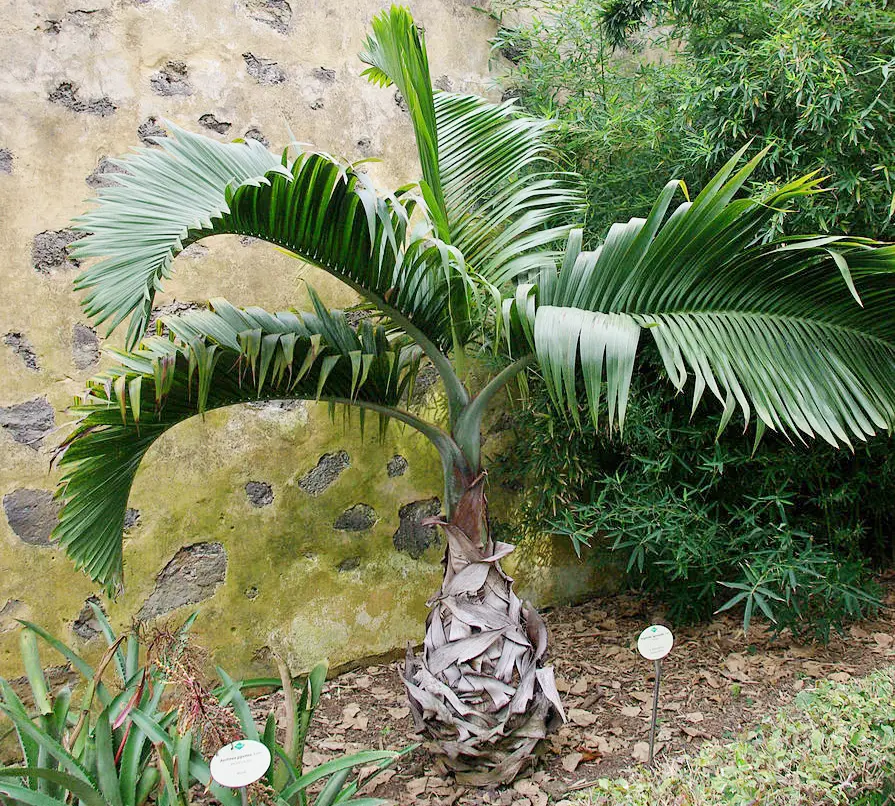This post contains affiliate links. If you buy something from one of our links we may earn a commission. Thanks
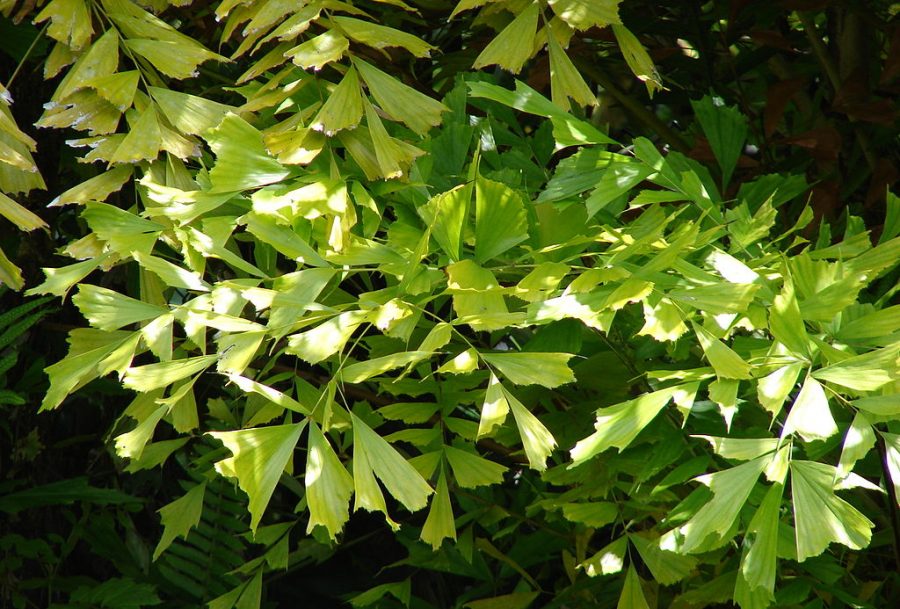
Discover the secrets to Fishtail Palm indoor care. Learn about optimal light, watering, soil, temperature, and more to keep your plant healthy & thriving. Get started now!
Fishtail Palm indoor care requires bright, indirect light, well-draining soil, and a warm humid environment. Regular watering without waterlogging the soil, occasional fertilizing during the growing season, and routine inspection for pests and diseases will ensure a healthy, thriving plant. Pruning and repotting every 2-3 years can further enhance its growth and aesthetic appeal.
Are you looking to bring a touch of tropical paradise into your home? Consider the Fishtail Palm, a beautiful and low-maintenance houseplant that adds both style and oxygen to any indoor space.
With its unique, feather-like leaves and elegant appearance, the Fishtail Palm is a perfect addition to any room.
However, in order to keep this plant thriving, it’s important to understand the basics of Fishtail Palm indoor care.
In this blog post, we’ll cover everything you need to know about providing the best possible environment for your Fishtail Palm, from light and water requirements to tips for avoiding common pests and diseases.
So sit back, relax, and get ready to learn how to keep your Fishtail Palm tree happy and healthy for years to come!
What Is A Fishtail Palm?
Fishtail Palm Quick Facts
| Mature Height: | 6-10 ft Indoors 20-25 ft Outdoors |
| Mature Width: | 4-5 ft Indoors 10-15 ft Outdoors |
| Sunlight: | Full-Partial |
| Growth Rate: | Moderate |
| Botanical Name: | Caryota mitis |
| Grows Well In Zones: | 4-11 patio / 9-11 outdoors |
You can buy Fishtail Palm Seeds here on Amazon
The Fishtail Palm, also known as Caryota, is a genus of tropical palm trees native to Southeast Asia and the Pacific Islands.
It is named for its unique leaves that resemble fishtails, hence the name Fishtail Palm.
These leaves grow from a single trunk and can reach lengths of up to 10 feet.
The Fishtail Palm is an evergreen plant that produces large clusters of tiny, yellow-green flowers, followed by small, black fruit.
Caryota mitis, known as the clustering fishtail palm or fishtail palm, is a species of palm native to Tropical Asia from India to Java to southern China.
Caryota mitis has clustered stems up to 10 m (33 feet) tall and 15 cm (6 inches) in diameter. Leaves can be up to 3 m (10 feet) long. Flowers are purple, and the fruits—harmful to humans—are dark purple or red. https://en.wikipedia.org/wiki/Caryota_mitis
Fishtail Palm Benefits As A Houseplant
Fishtail Palms are a popular choice for indoor plants due to their beauty and ease of care. Here are some of the benefits of having a Fishtail Palm in your home:
• Improves air quality: Fishtail Palms are natural air purifiers, removing harmful toxins from the air and releasing oxygen.
• Adds beauty to your home: With its unique leaves and elegant appearance, the Fishtail Palm is a beautiful addition to any room.
• Low maintenance: Fishtail Palms are relatively easy to care for, making them a great choice for those with busy lifestyles.
• Can help lower stress levels: Studies have shown that having plants in the home can help lower stress levels and improve overall well-being.
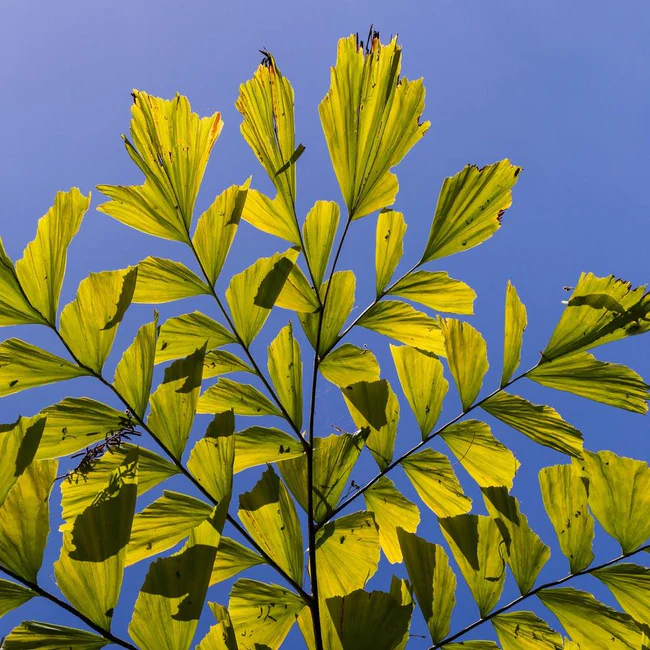
Fishtail Palm Indoor Care In A Nutshell
Caring for Fishtail Palms is relatively easy, but there are a few key things to keep in mind to ensure that your plant thrives.
Here is a quick overview of what you need to know to care for your Fishtail Palm indoors:
Light: Fishtail Palms prefer bright, indirect light but can tolerate some shade. Avoid direct sunlight, which can scorch the leaves.
Water: Water your Fishtail Palm regularly, but be careful not to overwater. The soil should be kept moist but not waterlogged.
Soil: Fishtail Palms prefer well-draining soil that is rich in organic matter. Repot your plant every two to three years to keep it healthy.
Temperature: Fishtail Palms prefer warm temperatures and should not be exposed to temperatures below 60°F.
Humidity: Fishtail Palms prefer high humidity levels, but can tolerate lower levels if the air is not too dry. Mist the leaves regularly to increase humidity.
By following these guidelines, you’ll be well on your way to having a happy and healthy Fishtail Palm in your home!
Light Requirements
Light is one of the most important factors when it comes to Fishtail Palm indoor care.
The right amount of light can help your plant thrive, while too little or too much light can cause problems.
In this section, we’ll take a closer look at the light requirements for Fishtail Palms and what you need to know to ensure your plant gets the right amount of light.
From optimal light conditions to the signs of too much or too little light, we’ve got you covered.
So, let’s dive in and learn how to provide the best possible light environment for your Fishtail Palm.
Optimal Light Conditions for Fishtail Palm
Fishtail Palms prefer bright indirect light but can tolerate some partial shade.
Ideally, place your plant near a window that receives bright, indirect light for several hours a day.
Avoid the full sun for best results, as this can scorch the leaves and cause damage to the plant.
If your Fishtail Palm is not getting enough light, its leaves may become yellow and droopy.
Signs of Too Much or Too Little Light
Here are some signs to look for to determine if your Fishtail Palm is getting too much or too little light:
Too much light: If your Fishtail Palm is getting too much light, the leaves may become yellow and dry, or the plant may become leggy and sparse.
Too little light: If your Fishtail Palm is not getting enough light, the leaves may become yellow and droopy, and the plant may not grow as vigorously as it should.
How to Adjust Light Conditions
If you notice that your Fishtail Palm is not getting the right amount of light, here’s what you can do:
Too much light: If your Fishtail Palm is getting too much light, move it to a location with less direct sunlight, or use sheer curtains to filter the light.
Too little light: If your Fishtail Palm is not getting enough light, move it to a brighter location or use a grow light to supplement its light requirements.
By paying attention to the light conditions for your Fishtail Palm and making adjustments as needed, you’ll help ensure that your plant stays healthy and thriving for years to come.
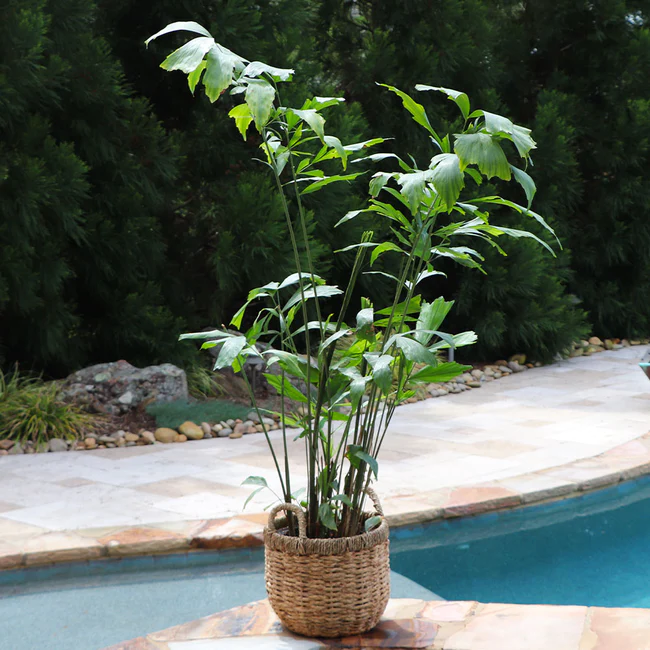
Watering and Humidity
Water and humidity are two crucial factors when it comes to Fishtail Palm indoor care.
Proper watering and humidity levels are essential for the health and growth of your plant.
In this section, we’ll take a closer look at the watering and humidity needs of Fishtail Palms, and what you need to know to keep your plant hydrated and healthy.
From how often to water to the signs of over- or under-watering, we’ve got all the information you need to keep your Fishtail Palm thriving.
So, let’s get into it and learn how to provide the perfect watering and humidity conditions for your Fishtail Palm.
How Often to Water Fishtail Palm
Fishtail Palms prefer evenly moist soil, but do not like to be consistently waterlogged.
It’s important to wait until the top inch of soil is dry to the touch before watering your Fishtail Palm again.
On average, this can be once a week, but this can vary depending on factors such as light, temperature, and humidity levels.
Signs of Overwatering or Underwatering
Here are some signs to look for to determine if you’re overwatering or underwatering your Fishtail Palm:
Overwatering: If you’re overwatering your Fishtail Palm, the roots may begin to rot and the leaves may turn yellow and mushy. You may also notice mold growing on the soil surface.
Underwatering: If you’re underwatering your Fishtail Palm, the leaves may become yellow and dry, and the plant may become stunted in growth.
Tap Water Can Cause Problems
Tap water may cause problems for your palm tree because it can contain harmful additives that build up in the soil over time.
It also has a higher pH than most plants like.
If you notice brown tips or edges on your palm’s leaves you might want to start using distilled water, or RO water or put a water filter on your tap.
Using rainwater is a great alternative.
Importance of Humidity for Fishtail Palm
Fishtail Palms prefer a slightly higher humidity level than the average home, so it’s important to provide extra humidity if necessary.
If you live in a dry climate, it’s especially important to keep an eye on the humidity levels for your Fishtail Palm and make adjustments as needed.
What is the ideal relative humidity level?
The ideal humidity level for Fishtail Palms is between 40-60%. This slightly higher level of humidity can help the plant stay healthy and thrive.
If the humidity level in your home is lower than this, you can increase it by using a humidifier, grouping plants together, or misting the leaves regularly, or using a humidity tray.
It’s important to monitor the humidity levels around your Fishtail Palm and make adjustments as needed to ensure that it stays healthy.
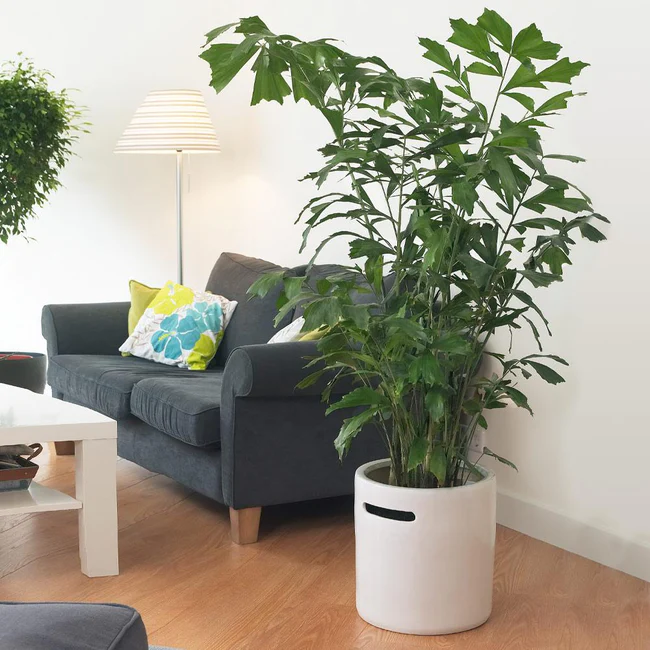
Soil Requirements
The soil your Fishtail Palm grows in is just as important as the light, water, and humidity it receives.
In this section, we’ll take a closer look at the soil requirements for Fishtail Palms, and what you need to know to provide the best growing conditions for your plant.
From the type of soil to use to the importance of good drainage, we’ll cover all the details you need to know to keep your Fishtail Palm healthy and thriving.
So, let’s get started and learn how to provide the perfect soil conditions for your Fishtail Palm.
Ideal Soil Type for Fishtail Palm
Fishtail Palms prefer well-drained soil that’s fertile and rich in organic matter.
A potting mix designed for tropical plants, or a mixture of peat moss, perlite, and sand, is ideal.
A potting soil mix of 50% coco coir and perlite makes great potting soil for these plants.
Avoid using heavy, dense soils that don’t drain well as this can lead to root rot.
How to Repot Fishtail Palm
It’s important to repot your Fishtail Palm every two to three years to ensure that it has enough space to grow and to refresh the soil.
When repotting, choose a pot that’s only slightly larger than the current one and make sure it has good drainage holes to get rid of any excess water.
After removing the plant from its current pot, gently loosen any tangled roots, then place the plant in the new pot and backfill it with fresh soil.
Water thoroughly to remove any air pockets. If the soil settles you can add more soil, if needed. But don’t bury the plant any deeper than it grew originally.
Common Soil Problems and How to Fix Them
Some common soil problem that can affect Fishtail Palms
Root Rot: Root rot is often caused by overwatering and poor drainage.
If your soil is mushy, has a bad smell, or has mold growing on top there is a good chance it was overwatered.
If you suspect root rot, remove the plant from the soil and look at the roots.
Trim off any dead, damaged or mushy roots and try replanting in fresh, well-draining soil. Obviously water less than before.
By following these guidelines for soil requirements, you can ensure that your Fishtail Palm has the best growing conditions.
Temperature and Airflow
The temperature and airflow in your home play a crucial role in the health and well-being of your Fishtail Palm.
In this section, we’ll take a closer look at the ideal temperature range for Fishtail Palms and how to maintain good airflow around the plant.
From avoiding cold drafts to protecting your plant from overheating, we’ll cover all the tips and tricks you need to know to keep your Fishtail Palm healthy and happy.
So, let’s get started and learn how to create the perfect temperature and airflow conditions for your Fishtail Palm.
Ideal Temperature Range for Fishtail Palm
Fishtail Palms prefer a temperature range of 60-85°F (15-29°C). They can tolerate a wider range of temperatures but are most comfortable in this range.
It’s important to avoid exposing your Fishtail Palm to extreme temperature changes, such as cold drafts or hot air from a heater, as this can cause stress to the plant.
Importance of Good Airflow
Good airflow is important for Fishtail Palms because it helps to prevent stagnant air, which can lead to mold and fungal growth.
It also helps to circulate fresh air, which is important for the plant’s overall health and well-being.
How to Ensure Optimal Temperature and Airflow Conditions
Here are some tips for ensuring optimal temperature and airflow conditions for your Fishtail Palm:
Place the Plant Away from Cold Drafts: Make sure to place your Fishtail Palm away from windows, doors, and other sources of cold drafts.
Provide Good Air Circulation: Keep your Fishtail Palm in a well-ventilated room and rotate the pot regularly to ensure even growth.
Use a Humidifier: If the air in your home is dry, consider using a humidifier to maintain an ideal humidity level of 40-60%.
Use a fan: It’s a good idea to place a small fan next to your palm that moves a gentle breeze through the canopy.
By following these tips, you can help ensure that your Fishtail Palm has the ideal temperature and airflow conditions.
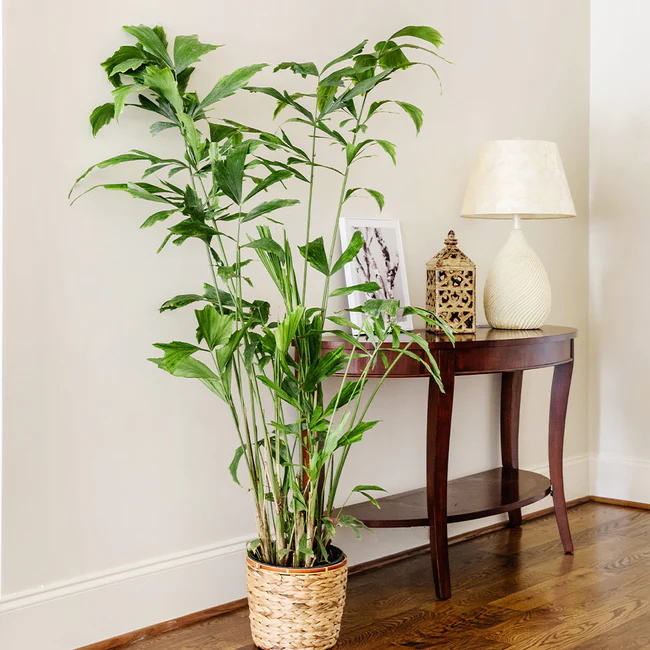
Fertilizing Fish Palms
The care of Fishtail palm also includes fertilizing, as this helps the plant to grow and maintain its lush, green appearance.
Fishtail palm benefits from regular fertilizing, particularly during the growing season, when it’s actively putting on new growth.
In this section, we’ll explore the best practices for fertilizing Fishtail palm, including when and how often to fertilize, what type of fertilizer to use, and how to properly apply fertilizer to your plant.
With the right fertilizing regime, you can help your Fishtail palm to grow to its full potential.
Key points to consider when it comes to fertilizing Fishtail palm:
• Timing: Fishtail palm should be fertilized regularly during its growing season, which is typically spring and summer. Fertilizing too much during the dormant winter months can harm the plant.
• Type of Fertilizer: A balanced, water-soluble fertilizer, such as a 20-20-20 fertilizer, is best for Fishtail palm.
Slow-release fertilizers can also be used, but be sure to follow the manufacturer’s instructions for application.
The use of tree spikes will take the guesswork out of fertilizing. Here is what I recommend for  fertilizing your fishtail palm.
fertilizing your fishtail palm.
I recommend using Jobes Organics fertilizer spikes.
They are easy to use and last for 2-3 months.
They are designed for container-grown citrus.
Using 2 spikes for a 12-inch pot or 3 for an 18-inch pot takes the guesswork out of fertilizing.
They provide a 3-5-5 fertilizer blend along with micronutrients and beneficial bacteria.
• Frequency: Fishtail palm should be fertilized once every two to four weeks during the growing season.
If using slow-release fertilizer, it’s important to follow the manufacturer’s instructions for application frequency.
• Application: Fertilizer should be mixed with water, according to the manufacturer’s instructions, and then applied directly to the soil.
Be careful not to get fertilizer on the leaves or trunk of the plant, as this can cause damage.
• Dosage: The recommended dosage of fertilizer will vary based on the specific product you are using, so be sure to follow the manufacturer’s instructions for best results.
Over-fertilizing can be harmful to the plant, so it’s important to use the correct amount of fertilizer.
By following these guidelines, you can help ensure that your Fishtail palm receives the proper nutrients it needs to thrive.
Regular fertilizing, combined with proper light, watering, and temperature, will help your Fishtail palm stay healthy and beautiful for many years to come.
Pests and Diseases
Just like any other houseplant, Fishtail Palms can be vulnerable to pests and diseases.
In this section, we’ll explore the most common issues that Fishtail Palms face and how you can prevent and treat them.
Whether it’s dealing with spider mites or battling root rot, we’ll cover everything you need to know to keep your Fishtail Palm healthy and free of pests and diseases.
So, let’s dive in and learn how to protect your Fishtail Palm from the most common problems it may encounter.
Common Pests Affecting Fishtail Palm
Some of the most common pests affecting Fishtail Palms include spider mites, scale insects, and mealybugs. These pests feed on the plant’s sap, causing yellowing and wilting of the leaves.
Symptoms of Pest Infestations
Some common symptoms of pest infestations on Fishtail Palms:
Yellowing and Wilting of Leaves: This can be a sign of sap-sucking pests, such as spider mites or mealybugs.
Webbing Under The Leaves: This is a telltale sign of a spider mite infestation.
Sticky Residue on Leaves: This is a sign of a mealy bug infestation.
Discolored Patches on Leaves: This can be a sign of scale insects, which can cause discoloration and brown patches on the leaves.
How to Control Pests on Fishtail Palm
Here are some tips for controlling pests on Fishtail Palms:
Regularly Inspect the Plant: Regularly inspect your Fishtail Palm for signs of pests and take action if you notice any.
Use Neem Oil: Neem oil is an effective and natural way to control pests on houseplants. Simply mix neem oil with water and spray it on the affected areas.
Use Insecticidal Soap: Insecticidal soap is another effective option for controlling pests on Fishtail Palms. Simply mix the soap with water and spray it on the affected areas.
Both these options will control pests but they work by making direct contact with pests so it is important to thoroughly spray all parts of the plant.
Common Diseases Affecting Fishtail Palm
Some of the most common diseases affecting Fishtail Palms include root rot, leaf spot, and fungal diseases. These diseases can be caused by overwatering, poor air circulation, and other environmental factors.
How to Prevent and Treat Diseases
Here are some tips for preventing and treating diseases on Fishtail Palms:
Avoid Overwatering: Overwatering is one of the main causes of root rot in Fishtail Palms.
Make sure to allow the soil to dry out between waterings and avoid letting the pot sit in standing water in the tray.
Improve Air Circulation: Good air circulation can help prevent fungal diseases from developing on your Fishtail Palm.
Make sure to place the plant in a well-ventilated room and rotate the pot regularly.
Raise Humidity: Spider mites thrive in low humidity. Raising humidity levels will help discourage them.
Use Fungicides: If your Fishtail Palm is infected with a fungal disease, you can use fungicides to control the problem. Make sure to follow the instructions carefully and treat the plant regularly until the disease is under control.
By following these tips, you can help prevent and treat common pests and diseases that can affect your Fishtail Palm, keeping it healthy and thriving for years to come.
Pruning and Trimming
Pruning and trimming are important aspects of Fishtail Palm indoor care.
Regular pruning helps maintain the plant’s shape and encourages healthy growth while removing dead or damaged leaves can help prevent the spread of pests and diseases.
In this section, we will cover the basics of pruning and trimming Fishtail Palms, including when to prune, how to prune, and the benefits of pruning.
When and How to Prune Fishtail Palm:
Fishtail palm (Caryota mitis) is a tropical plant that can grow up to 80 feet tall in its natural habitat, but it is commonly grown as a houseplant or in a conservatory.
It is important to prune this plant regularly to keep it healthy and to encourage new growth.
The best time to prune Fishtail palm is in spring or early summer, when new growth is starting to emerge.
To prune, use a clean, sharp pair of pruning shears and make cuts just above a node which is the point on a stem where leaves can grow.
This will encourage new growth to emerge from the node.
Importance of Regular Trimming:
Regular trimming of Fishtail palm helps to keep the plant healthy and to encourage new growth.
It also removes yellow or dead leaves, which can harbor pests and diseases.
Pruning also helps to maintain the shape of the plant and to prevent it from becoming too large for its space.
How to Remove Yellow or Dead Leaves:
To remove yellow or dead leaves from Fishtail palm, use a clean, sharp pair of pruning shears to cut the leaves just above the node.
This will encourage new growth to emerge from the node. It is important to dispose of the dead leaves, as they can harbor pests and diseases.
While removing yellow leaves, it is also important to check for pests or diseases that may be affecting the plant.
If you notice any signs of pests or diseases, treat the plant immediately to prevent further damage.
Propagation of Fishtail Palm
Fishtail palm, also known as Caryota, is a beautiful and unique houseplant that is highly prized for its tropical appearance and low maintenance requirements.
While Fishtail palm can be purchased as a mature plant, it can also be propagated through seeds or by dividing the root ball of an existing plant.
Whether you’re looking to expand your collection of houseplants or simply want to try your hand at propagation, Fishtail palm is a great choice.
In this section, we’ll explore the steps and best practices for propagating Fishtail palm so that you can enjoy this stunning plant in your own home.
Propagation through seeds:
• Collect the seeds from a mature Fishtail palm plant. You can usually buy seeds online too.
• If you want to get started right away this is the best way if your plant is not mature enough to flower.
• Clean and dry the seeds, then sow them in a well-draining soil mixture.
• Cover the seeds lightly with soil and water them gently.
• Place the container in a warm, bright location and keep the soil moist but not waterlogged.
Germination can take several weeks to a few months, and seedlings should be kept in a warm and bright location until they are big enough to be potted up.
Propagation through division:
Fishtail palm can be propagated by dividing the root ball of a mature plant.
• The best time to do this is when your plant needs to be repotted anyway.
• Carefully remove the plant from its pot and gently separate the root ball into two or more sections using a sharp knife.
• Each section you make should have some roots and foliage.
• Replant each section into a pot with well-draining soil and water well.
• Place the newly potted plants in a warm, bright location and keep the soil moist but not waterlogged.
Propagating Fishtail palm is an easy and effective way to create new plants for your collection or to share with friends and family.
With proper care, these new plants will grow and thrive, bringing a touch of the tropics to your home.
FAQs about Fishtail Palm Indoor Care:
Fishtail Palms are a popular choice among houseplant enthusiasts for their unique appearance and easy care routine.
However, like with any plant, certain questions arise regarding their maintenance, especially when it comes to watering, fertilizing, pest control, and the right temperature conditions.
The following FAQs address some common concerns and provide insights to ensure your Fishtail Palm thrives indoors.
Q. How often should I water my Fishtail Palm?
A. Water your Fishtail Palm when the top inch of soil is dry, usually once a week. Avoid waterlogging the soil as it can lead to root rot.
Q. What kind of fertilizer is best for Fishtail Palm?
A. Use a balanced, water-soluble fertilizer like a 20-20-20 mix during the growing season, spring and summer, every two to four weeks. Slow-release fertilizers or organic fertilizer spikes are also good options.
Q. How do I manage pests on my Fishtail Palm?
A. Inspect regularly for pests like spider mites, mealybugs, or scale insects. If detected, use neem oil or insecticidal soap sprays, ensuring thorough coverage on all parts of the plant.
Q. What is the ideal temperature for Fishtail Palm?
A. Fishtail Palms thrive in temperatures between 60-85°F (15-29°C). Avoid placing them near cold drafts or heat sources to maintain a consistent temperature.
Final Thoughts For Fishtail Palm Indoor Care
In conclusion, Fishtail palm indoor care is easy and straightforward.
Regular pruning, watering and providing the right conditions of light, soil, and temperature can keep the plant healthy and encourage new growth.
Fishtail palm is a beautiful, low-maintenance houseplant that can add a tropical touch to any home.
With its graceful, feather-like leaves, it is sure to be a conversation starter.
If you are looking for a new houseplant, we highly encourage you to try Fishtail palm.
You can buy Fishtail Palm Seeds here on Amazon
With proper care, it will bring beauty and life to your home for many years to come.
Here are the key points for Fishtail Palm Indoor Care:
Optimal Light Conditions for Fishtail Palm
Watering and Humidity Requirements
Ideal Soil Type and Repotting
Ideal Temperature Range and Air Flow Requirements
Common Pests and Diseases and How to Control Them
Pruning and Trimming Requirements
Propagation of Fishtail Palm
These are the key points that should be covered when discussing Fishtail Palm Indoor Care.
Read our complete guide on Indoor Palm Tree Care: 11 Powerful Tips Complete Guide For Beginners






